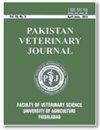部分植物甲醇和水叶提取物的体外抗球虫、抗氧化活性及生化筛选
IF 5.4
3区 农林科学
Q1 VETERINARY SCIENCES
引用次数: 25
摘要
禽球虫病,一种由艾美耳球虫属引起的原生动物寄生虫病。由于耐药艾美耳球虫品种的出现,本研究旨在评价总形榕、决明子和细穗叶提取物的抗球虫活性。通过对艾美耳球虫混合种卵囊的抑孢试验和孢子子活力抑制试验,评价提取物的体外抗球虫效果。孵育48小时后检查各组。以DPPH自由基清除能力、铁还原能力和总抗氧化能力评价提取物的抗氧化潜力。当浓度为30 mg/ml时,对卵囊产孢的抑制作用最大,为86.81±2.35%;对孢子子活力的抑制作用最大,为86.73±1.67%。总状叶提取物的自由基清除能力最高,为67.82±0.00,还原能力最高,为2.17±0.01。总抗氧化能力最高的是荆芥叶提取物(30.95±0.35)µg/mg,荆芥叶提取物(21.93±1.41)µg/mg。通过生化筛选,筛选出酚类、类黄酮、生物碱、皂苷、碳水化合物等抗氧化成分。其中酚类含量最高达32.50±0.00µg/ml,黄酮类含量最高达40.00±1.00µg/ml。因此,所选植物甲醇提取物由于含有重要的药用化学物质,具有较好的抗球虫和抗氧化活性。从这些植物中鉴定和分离抗球虫活性化合物,用于球虫药物的配制,还需要进一步的研究本文章由计算机程序翻译,如有差异,请以英文原文为准。
In vitro Anticoccidial, Antioxidant Activities and Biochemical Screening of Methanolic and Aqueous Leaves Extracts of Selected Plants
Avian coccidiosis, a protozoan parasitic disease caused by genus Eimeria. Due to emergence of drug resistant Eimeria species, this study was aimed to evaluate anticoccidial potentials of Ficus racemosa, Cassia fistula and Syzygium cumini leaves extracts. In vitro anticoccidial efficacy of extracts was evaluated by oocysts sporulation inhibition and sporozoites viability inhibition assays of mixed Eimeria species oocysts. The set up was examined after 48hrs of incubation. DPPH radical scavenging activity, ferric reducing antioxidant power and total antioxidant capacity were used for the evaluation of antioxidant potential of extracts. Among tested extracts maximum oocysts sporulation inhibition 86.81±2.35% and sporozoites viability inhibition was 86.73±1.67% at concentration 30 mg/ml of C. fistula methanolic leaves extract against E. mitis and E. tenella respectively. Highest radical scavenging capacity 67.82±0.00 and reducing power 2.17±0.01 was shown by F. racemosa and C. fistula methanolic leaves extract respectively. Maximum total antioxidant power was observed in C. fistula 30.95±0.35 and F. racemosa 21.93±1.41µg/mg methanolic leaves extracts. Antioxidant compounds including phenols, flavonoids, alkaloids, saponins, carbohydrates etc. were detected through biochemical screening of selected plants extracts. The maximum amount of phenols 32.50±0.00µg/ml and flavonoids 40.00±1.00µg/ml were recorded in C. fistula methanolic extracts. It is concluded that selected plants methanolic extracts possess best anticoccidial and antioxidant activities due to presence of medicinally important phytochemicals. Further research is needed for identification and isolation of anticoccidial active compounds from these plants that can be used in the formulation of drugs against coccidiosis
求助全文
通过发布文献求助,成功后即可免费获取论文全文。
去求助
来源期刊

Pakistan Veterinary Journal
兽医-兽医学
CiteScore
4.20
自引率
13.00%
发文量
0
审稿时长
4-8 weeks
期刊介绍:
The Pakistan Veterinary Journal (Pak Vet J), a quarterly publication, is being published regularly since 1981 by the Faculty of Veterinary Science, University of Agriculture, Faisalabad, Pakistan. It publishes original research manuscripts and review articles on health and diseases of animals including its various aspects like pathology, microbiology, pharmacology, parasitology and its treatment. The “Pak Vet J” (www.pvj.com.pk) is included in Science Citation Index Expended and has got 1.217 impact factor in JCR 2017. Among Veterinary Science Journals of the world (136), “Pak Vet J” has been i) ranked at 75th position and ii) placed Q2 in Quartile in Category. The journal is read, abstracted and indexed internationally.
 求助内容:
求助内容: 应助结果提醒方式:
应助结果提醒方式:


